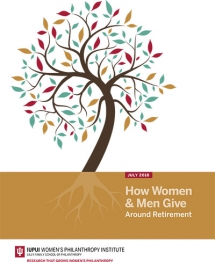New research from the Women’s Philanthropy Institute uncovers gender differences in charitable giving and volunteering around retirement
A new report from the Women’s Philanthropy Institute is the first known scholarly research examining how retirement affects charitable giving.
The study finds that while most households decrease their overall spending around retirement, they generally maintain charitable giving levels — but gender differences exist. Single women and married couples are more likely to give, give more and give more consistently than single men in the years surrounding retirement. Single women and married couples are also more likely than single men to volunteer at this time in their lives.
As the number of retirees continues to grow rapidly—10,000 Baby Boomers will turn 65 every day through 2030, and those over 65 now represent 15 percent of the total population—How Women and Men Give Around Retirement is the first study to look at the intersection of gender and philanthropy among this age group. Funded by a grant from the Bill & Melinda Gates Foundation, the research raises important considerations for nonprofits, wealth advisors, and philanthropists alike.
"The findings show that retirees continue to be generous during their retirement – even as other spending decreases – and that the way women and men address charitable giving later in life is a continuation of patterns established much earlier,” said Debra J. Mesch, Ph.D., director of the Women’s Philanthropy Institute and the Eileen Lamb O’Gara Chair in Women’s Philanthropy at the Indiana University Lilly Family School of Philanthropy at IU Indianapolis.
“With an unprecedented number of people retiring and women’s wealth on the rise, these findings underscore how important it is for the philanthropy community to understand how women and men give around retirement, and consider evolving their strategies accordingly,” Mesch said.
Key findings from How Women and Men Give Around Retirement include:
- Both men and women maintain their charitable giving after retirement, especially compared to other types of spending, which typically decrease at this stage in life.
- Around retirement, single women and married couples are more likely to give and give more than single men. These gender differences are consistent with patterns seen both before and after retirement.
- Around retirement, giving by single women and married couples is more stable than giving by single men. Single men’s likelihood of giving and amount of giving varies widely from year to year, compared to single women and married couples.
- Around retirement, single women and married couples are more likely to volunteer, and their likelihood of volunteering is more constant over time, compared to single men.
About the Women’s Philanthropy Institute
The Women’s Philanthropy Institute (WPI) is part of the Indiana University Lilly Family School of Philanthropy at IU Indianapolis. WPI increases understanding of women’s philanthropy through rigorous research and education, interpreting and sharing these insights broadly to improve philanthropy. By addressing significant and groundbreaking research questions and translating that research into increased understanding and improvements in practice, WPI helps to leverage new and expanded resources for the common good. Follow us on Twitter @WPIinsights and “Like” us on Facebook.
About the Indiana University Lilly Family School of Philanthropy
The Lilly Family School of Philanthropy at IU Indianapolis is dedicated to improving philanthropy to improve the world by training and empowering students and professionals to be innovators and leaders who create positive and lasting change. The school offers a comprehensive approach to philanthropy through its academic, research and international programs and through The Fund Raising School, Lake Institute on Faith & Giving and the Women’s Philanthropy Institute. Follow us on Twitter @IUPhilanthropy or “Like” us on Facebook.


